How I got to interview a king
Faithful readers of this newsletter, along with my Facebook followers, know that I was recently in the Netherlands. Now, there’s nothing newsworthy in that—I’ve been like 15 times in the last 20 years for horticulture shows and greenhouse visits. But this trip was different: I was going to meet and interview the king of the Netherlands, King Willem-Alexander, who gained that title two years ago when his mother, Queen Beatrix, abdicated the throne. This special Acres Online is devoted to that trip. (Don’t worry, there’s horticulture involved, including a new greenhouse design that turns your glazing into part of your heating system!)
Why the king? And why me?
Why the king? Because he and his wife, Queen Maxima, are coming to North America on an economic and cultural trade mission. After three days in Canada, he’s visiting Washington D.C., Michigan and Chicago June 1-3, and the Dutch Embassy in Washington thought it would be appropriate to get journalists from those three regions over to the Netherlands in advance of his tour to share stories of Dutch technology that the king will be touting. Being from Chicago, and having that Dutch Embassy connection, and being versed in some of the agricultural technology they wanted to show off, all added up to me getting the call.
Why me? Clean living and good fortune … and maybe my good relationship with the Dutch Embassy in Washington, from to a few previous trips (thank goodness I always pay my Dutch speeding tickets!). And it’s not me, per se, it’s GrowerTalks and Acres Online, which provide me the platform to share news with the horticulture world.
As implied, I wasn’t alone. Six other American journalists were on the trip—two others from Chicago, two from the Grand Rapids/Holland, Michigan area; and one from Washington, D.C. (A Reuters reporter based in Amsterdam joined us for a portion of the tour and the meeting with the king). We represented two daily papers, a hospital industry trade magazine, a diplomatic monthly newspaper and Northwestern University’s Medill School of Journalism. And the greenhouse sector.
Oh, and one other note: We seven were the first American journalists to interview the king! Imagine that—little GrowerTalks beat out the New York Times!

Remembering the sacrifices of WWII
This trip was unique for me because of the wide variety of stops we made. Such as Margraten Cemetery, a U.S. military cemetery established near the German border during WWII to accommodate the many casualties from that region. Some 18,000 Americans were buried there; after the war families were given the option of having their loved ones returned home, and about 10,000 did so. But 8,301 remain, along with 1,722 whose names are engraved on the Wall of Missing. A sad place.
But what was so heartwarming was to learn that every grave and nearly every missing soldier’s name has been adopted by a Dutch, German or Belgian family, who bring flowers to the cemetery every Memorial Day to commemorate their sacrifice on behalf of the Dutch people. This has been going on since 1945, starting with the citizens of Margraten. We were all touched!

This year being the 70th anniversary of the end of WWII, King Willem-Alexander visited Arlington National Cemetery to place a wreath on the Tomb of the Unknown Soldier.
The Dutch: Leaders in healthcare
A big portion of the king’s visit to the U.S. revolves around healthcare and life sciences, and several partnerships between Dutch and U.S. researchers will be formalized during his visit.
We met two of those Dutch researchers. One was Dr. Bas Bloem, a world-renowned neurologist and specialist in Parkinson’s Disease and other movement disorders (he joked that “anything that shakes, jolts, jerks or trembles, they all come to me”). Parkinson's sufferers include Muhammed Ali and actor Michael J. Fox.
Dr. Bloem has developed “ParkinsonNet,” a network of trained Parkinson’s specialists in the Netherlands, which has shown to improve care results while lowering costs. California’s Keiser Permanente, which is both an insurer and a hospital network, has adopted the ParkinsonNet model and is rolling it out across California. It could be adopted for other chronic diseases as well.
HERE is a brief interview with Dr. Bloem conducted by Matthew Winestock of Hospitals & Health Network magazine, one of my fellow travelers.
Later that same day we visited the Hubrecht Institute, one of the world leaders in developmental and stem cell* research—they are rated as high or higher than MIT, Stanford and Harvard. There we met Alexander van Oudenaarden, the 45-year-old genius who runs the Institute. I say genius because he’s a PhD biophysicist and Stanford post-doc who was a professor and lab director at MIT before taking the opportunity to run Hubrecht (did I mention he’s only 45?). He oversees 175 scientists from 40 countries, with an average age of around 30! Truly gives you hope for the future!
There, we learned about tiny zebra fish and how they share 80% of their genomes with humans, making them perfect research specimens. (Also, they can regenerate damaged heart tissue, something we can’t do, which the researchers are trying to unlock.)
After the banks of aquariums, we were led to a lab and shown dishes of “organoids”—living tissue taken from donors and grown in the lab. Called a “biobank,” they are learning how to grow both healthy and diseased tissue in this way, which will eventually allow them to test treatment regimes directly on a donor’s tissue, to better tailor treatments—personalized medicine. They’re working with various cancers right now, including pancreatic, breast, colorectal, lung and ovarian, plus cystic fibrosis. The eventual goal? Regenerative medicine—growing new organs from a donor’s tissue.
*Primarily adult, not embryonic, stem cells, which can be reprogrammed to become pluripotent stems cells capable of developing into all tissues of the body.
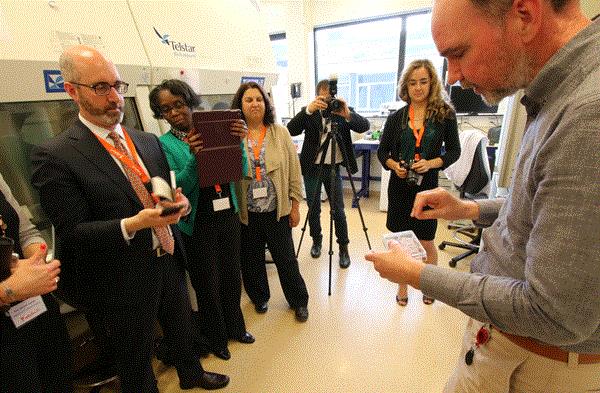 Dr. Marc van de Wetering showing us a dish of cancer organoids.
Dr. Marc van de Wetering showing us a dish of cancer organoids.
Where healthcare and urban farming collide
In previous tours of the Netherlands, I’ve visited Philips to see their LED technology at work in the greenhouse and in warehouse “urban farming” settings. We did that this time, too, but we also visited Philips Healthcare, which specializes in medical imaging and MRI technology. Talk about cutting-edge machines! This was way beyond the greenhouse robots I’m used to seeing. Philips has a showroom set up to look like a hospital, which we toured to see the very latest in technology.
Some of it does tie in to their lighting division, such as a hospital room that has lighting that changes throughout the day to closely mimic natural daylight intensity and color. It’s said to improve the quality of sleep for hospital patients.
The visit to Philips Lighting, and also to vertical farming pioneer PlantLab, both of which were showing off indoor growing technology using LED lights, was where I feel my background benefitted the group. Both visits started off with this statement: “By the year 2050, there will be 9 billion people on Earth—2 billion more than today—and we have to find a way to feed them. Vertical farming is the solution,” and then on to a description of vertical indoor growing.
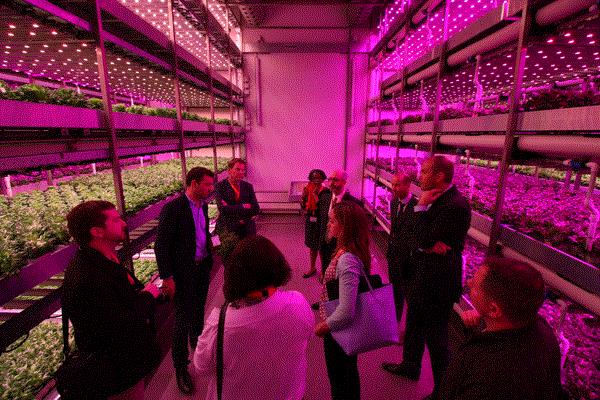
It would be easy for the uninitiated to think that traditional farms are going to be replaced by LED-lit boxes. But I pointed out to the group that the top ten global food crops, which include corn, wheat, rice, sorghum and soybeans, are not likely to be economically viable candidates for indoor growing except in the most extreme locations.
Not that there isn’t a place for vertical farming technology, but it will supplement, not replace, traditional ag, and most likely with fast-turn, high-value crops.
Finally, a greenhouse!
Wednesday morning, a few hours before our meeting with the king, we went to Ter Laak Orchids, which I visited and videotaped in 2011 (see that video HERE). Owned by Richard and Eduard Ter Laak, this is the epitome of the best of Dutch greenhouse and internal transport technology, combined with modern Dutch marketing methods that are replacing the Dutch auction system, at least in potted plants. They grow and sell some six million phalaenopsis a year across Europe.
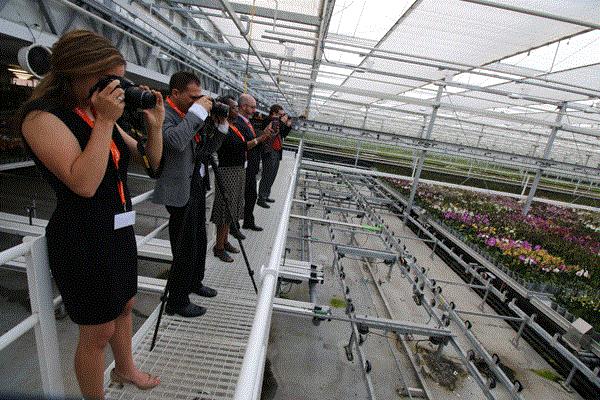
For marketing, Ter Laak has an actual working florist shop in their building that’s open to the public Thursday through Saturday. It’s the perfect new product test bed. We saw one item that’s been successful: Meander, a phalaenopsis with a spiral-shaped bloom spike packaged in a novel black and gray carrier.
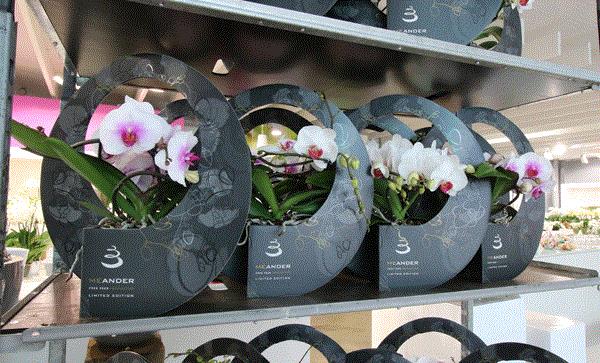
They’re also getting into “category management”: starting in Germany, they run orchid departments in 30 to 40 stores where they have their own staff managing and maintaining the plants. It’s expensive, Richard says; they hope to find a way to manage the departments with outside contract staff.
I mentioned their greenhouse. At 20 acres, it’s enormous. One acre of it is now what’s called a “DayLight” Greenhouse, by greenhouse manufacturer Technokas. The Daylight house captures the sun energy and converts it into heat that can be stored for later use.
How does it work? The greenhouse is glazed with two layers of glass. Between the layers are Fresnel lenses that direct the light onto movable collectors, which convert the light into heat, which is stored in an underground buffer for later use. The remaining light coming into the house is diffused, giving uniform, quality light for the crop. And since much of the heat has been captured, the greenhouse stays cooler. It’s said to produce energy while using less energy. Ter Laak has the first commercial version of the system.
Here’s a VIDEO describing the technology.
(Speaking of agriculture, did you know that the Netherland’s is the world’s number two exporter of agricultural products, only behind the U.S. That from a country just a bit larger than Maryland. How? High-value crops produced extremely intensively, whether in fields or greenhouses.)
Interviewing the king
There were many more stops, including an egg farm, Tomatoworld (an information and education center serving the greenhouse vegetable sector), research into “neuroplasticity”—the adaptive capacity of the brain—and even “self-healing” concrete (more on that next time). But on to the king, which was the highlight of our trip.
We were nervous. Lots of nervous chatter and joking on the bus. One of our Dutch guides said, “It’s just a conversation with a guy … who happens to be king.” We were not comforted. I mean, how often do you go to a palace to interview a king? Never!
Upon arrival at Noordiende (north end) Palace, the king’s working palace and office, we were greeted by a tall young man in tails who led us into a fancy parlor, where we waited to meet the Grand Master of the Royal Household, Marco Hennis. We were then led to Marco’s own palatial office, a long, narrow room with a conference table at one end that we gathered around. Marco was a charming older gentleman who immediately began some good-natured joshing with the younger fellow seated at his right, the personal secretary to the king, which put our group at ease. This was not quite as formal as it appeared (although we were all in proper business attire—this was NOT a greenhouse visit).
Marco briefed us on the duties of the king in the Netherlands. Primarily, it is to bring attention to topics of great importance to the Netherlands and the world without politicizing them. In fact, the king stays out of politics, with no official opinion. We weren’t allowed to ask him any political questions. He lets Parliament deal with that.
The other function of the royal family is of course to provide symbolism that goes back some 200 years in the Netherlands—“but the right kind of symbolism,” Marco said.
At 48, the king is young. And his wife, Queen Maxima, an Argentinian, seems to be as beloved in Holland as Princess Diana was in England. They have three young daughters and are as “normal” as any royal couple could possibly be—unpretentious, smart and modern.
At 2 p.m. on the dot, after a visit to the washroom (and at least one joke about a “royal flush"), we were led up a carpeted staircase, down a hall and into the ornate "Putty Room," where King Willem-Alexander himself was in the doorway to greet us with a handshake and a smile. It was just like any other business meeting … except for my never-before-uttered reply of “It’s an honor to meet you, your majesty”—which I somehow got out in one piece without babbling.
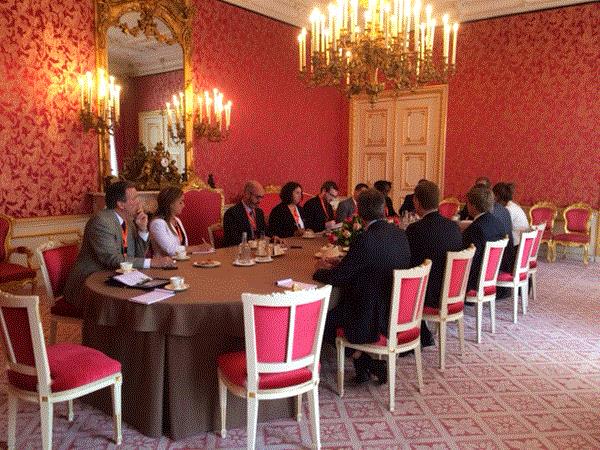 Your's truly listens in rapt attention ... while deciding if it's protocol to eat the royal cookies.
Your's truly listens in rapt attention ... while deciding if it's protocol to eat the royal cookies.
We were seated around a long conference table, the king and his entourage on one side, us journalists and our Embassy guides on the other. The king gave a few minutes of briefing about the 400-year relationship between the Netherlands and the U.S. and his upcoming trip to our cities, and then opened the floor to questions.
This caught us by surprise. We were asked to submit our questions several days in advance, and we assumed they would either be addressed by the king, or we would be called on to ask them. But he simply said have at it, and waited.
After a moment of silence, I suggested “Ladies first?” and indicated Meghan Morris, a grad student and freelancer from Northwestern University seated at my left. Meghan’s question about what he was looking forward to seeing in Chicago broke the ice, and things proceeded just like any other interview after that. I even had the cool presence of mind to try the royal coffee and cookies placed for our convenience—I wasn’t going to miss that out of a sense of politeness. Plus, I noticed Marco chowing down at the other end of the table, so figured if he could do it, so could I.
My question to the king was the same one I ask many of my growers: “What keeps you up at night?” He had to pause a while before answering that his function as a monarch is a strange one. He has to serve everyone—even if they don’t want to be served by him—and be as impartial as possible, plus gather enough information to make good decisions, all while remaining in the background, as he is not a politician or an executive in the government.
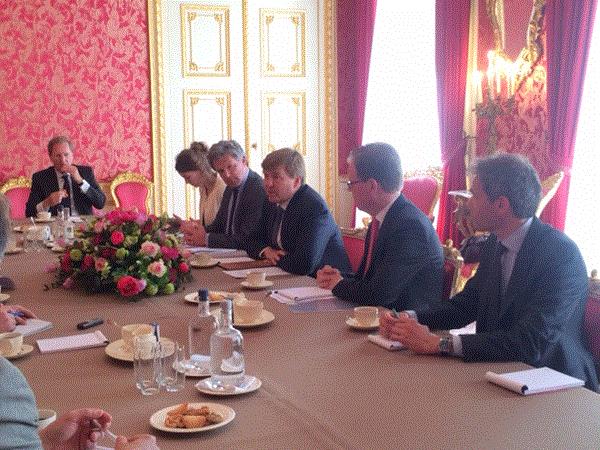 That's the king in the center. Just an ordinary guy ... who happens to be king. Marco is far left.
That's the king in the center. Just an ordinary guy ... who happens to be king. Marco is far left.
I asked if he has to bite his tongue on topics as he stays in the background. His reply that his tongue would fall off, he’s bitten it so many times, drew laughter from everyone, including his staff.
We could have gone on for hours, but, alas, had just 30 minutes exactly. Upon departing, we got another handshake, and I told the king that I hoped to see him during his visit to the new Gotham Greens rooftop greenhouse atop the Method eco-friendly soap factory just south of Chicago.
Then it was back outside to the real world—and an interview with Dutch television network NOS, which AIRED later that day. Several of my Dutch friends were surprised to see my face on their nightly news, and links to the story were sent all the way back to West Chicago.
Finally I …
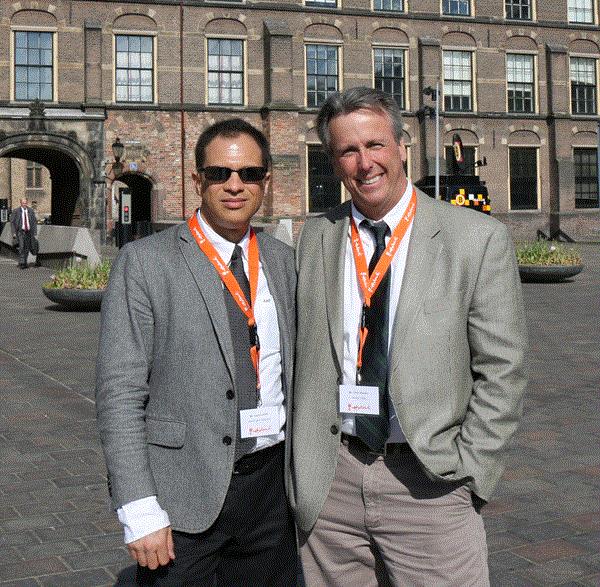
It really is a small world. I found that out when chatting on our tour bus with one of my fellow journalists, Larry Luxner, from the Washington Diplomat. The subject of education came up, and one of us mentioned the University of Florida. The other said, “Hey, I went to UF. When did you graduate?”
“1983.”
“Me, too!”
Turns out we were in journalism school together, although neither had any recollection of the other.
To make the world even smaller, he mentioned having written a few times in the ’90s for a magazine called FloraCulture International (he’s an expert on Central and South America and the Caribbean). Was I familiar with it?
Um, yeah! I told him Ball Publishing founded FCI and I was managing editor for several years. I’m still a contributing editor (it’s now under new ownership in the Netherlands).
We plan to write something up about our strange reconnection for the Alumni magazine, if either of us can ever find the time.
Finally II …
Thanks for indulging me and my long tale of the king and I (you expected that one at some point). It’s never happened before and it’s not likely to happen again, so I wanted to get it all down on paper.
I promise my brush with royalty won’t go to my head ... much!
See you next time!

Chris Beytes
Editor
GrowerTalks and Green Profit
This e-mail received by 27,758 loyal readers!
Thanks to my loyal sponsors, who help me reach the 27,758 readers of Acres Online in 68 countries! Want to be one (a sponsor, that is)? Give Paul Black a shout and he'll hook you up.